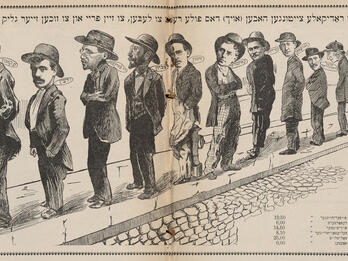Sadie Salome, Go Home!
Irving Berlin
Fanny Brice
Edgar Leslie
1909
Verse 1
Creator Bio
Irving Berlin
Irving Berlin was born Israel Isidore Baline in Mogilev province (today in Belarus); his father was a cantor. The family immigrated to New York City in 1893, and in 1901, his father died, leaving Irving (as he would later call himself) to busk on the Lower East Side. He copublished his first song in 1907, and in 1911 came out with his national sensation, “Alexander’s Ragtime Band.” In 1917, Berlin wrote “God Bless America” for the musical review Yip Yaphank!, but he did not release it until 1938, assigning all of its royalties (and those of his other patriotic songs) to charities. Berlin was a leading advocate for the intellectual property rights of authors, songwriters, and composers. He remains one of the most accomplished of songwriters for Tin Pan Alley, Broadway, and Hollywood. His most famous song, recorded hundreds of times, is one of the most beloved Christmas songs in the American songbook, “White Christmas.”
Creator Bio
Fanny Brice
Fanny Brice was born Fania Borach in New York City to immigrants from Hungary and Alsace respectively. Getting her break into entertainment through the Eastern Burlesque Circuit (1907–1910), Fania Anglicized her name to Fanny Brice. She was intermittently cast in Ziegfield’s Follies for the next thirteen years with her Yiddish-accented humor, performing Irving Berlin and Edgar Leslie’s “Sadie Salome, Go Home” for the 1910 Follies. Brice became the first female lead of a talkie, My Man (1928), based on her popular performances of this song in the 1921 Follies, for which she was awarded a posthumous Grammy Award.
Creator Bio
Edgar Leslie
Born in Stamford, Connecticut, and educated at Cooper Union College, Edgar Leslie wrote his first hit song in 1909 (“Lonesome”) with the Haydn Quartet. He went on to collaborate with Irving Berlin and other Tin Pan Alley writers, Jewish and not. With Berlin, Leslie was a founding member of the American Society of Composers, Authors, and Publishers that protected the intellectual property rights of these authors, and he later cofounded the Songwriters Protective Association (now the union Songwriters Guild of America). His songs were featured in The Jazz Singer (1927), Moon over Miami (1941), and For Me and My Gal (1942).
Language:
Places:
You may also like
On Otto Weininger’s Sex and Character

Unemployed Yiddish Writers
Lamentation for Those Who Perished in the Abriyah Earthquake
A Jewish Oud Player Entertains for Ramadan
The Golem



